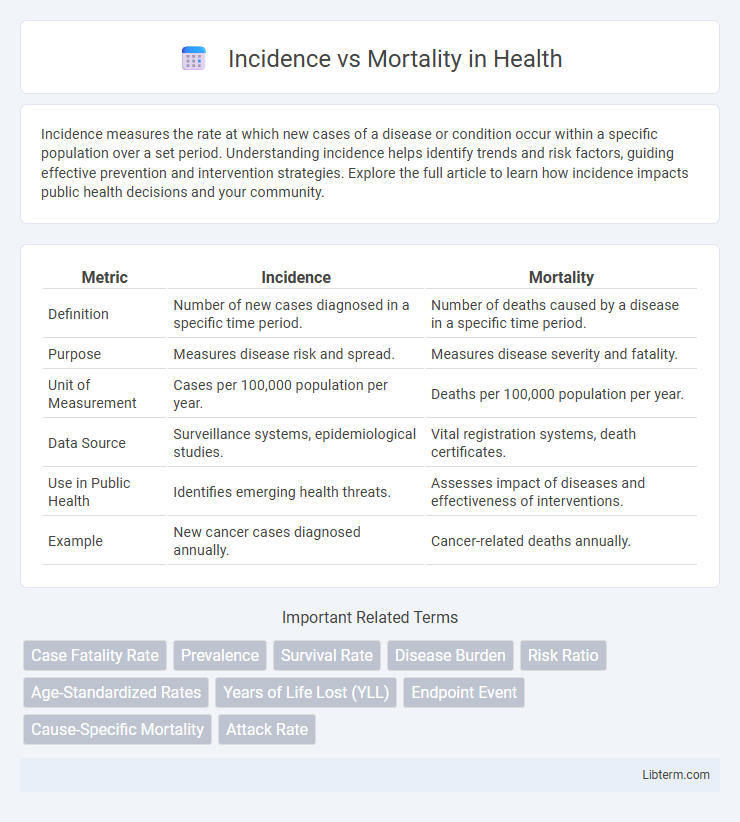Incidence measures the rate at which new cases of a disease or condition occur within a specific population over a set period. Understanding incidence helps identify trends and risk factors, guiding effective prevention and intervention strategies. Explore the full article to learn how incidence impacts public health decisions and your community.
Table of Comparison
| Metric | Incidence | Mortality |
|---|---|---|
| Definition | Number of new cases diagnosed in a specific time period. | Number of deaths caused by a disease in a specific time period. |
| Purpose | Measures disease risk and spread. | Measures disease severity and fatality. |
| Unit of Measurement | Cases per 100,000 population per year. | Deaths per 100,000 population per year. |
| Data Source | Surveillance systems, epidemiological studies. | Vital registration systems, death certificates. |
| Use in Public Health | Identifies emerging health threats. | Assesses impact of diseases and effectiveness of interventions. |
| Example | New cancer cases diagnosed annually. | Cancer-related deaths annually. |
Understanding Incidence and Mortality
Incidence refers to the number of new cases of a disease or condition occurring within a specific population during a defined time period, providing vital information about the risk and spread of the disease. Mortality measures the number of deaths caused by a disease in a population over a given period, reflecting the severity and fatality associated with the condition. Understanding both incidence and mortality rates is crucial for public health planning, resource allocation, and evaluating the effectiveness of prevention and treatment strategies.
Defining Key Epidemiological Terms
Incidence refers to the number of new cases of a disease occurring within a specified population during a given time period, providing crucial data on disease risk and spread. Mortality measures the number of deaths caused by a disease within a population over a certain time frame, highlighting its lethality and public health impact. Understanding incidence and mortality rates is essential for epidemiologists to design effective prevention strategies and allocate healthcare resources efficiently.
Differentiating Incidence from Mortality
Incidence refers to the number of new cases of a disease occurring in a specific population during a defined time period, highlighting the risk of developing the condition. Mortality measures the number of deaths caused by the disease within the same population and timeframe, reflecting the disease's lethality. Differentiating incidence from mortality is critical for understanding disease dynamics, guiding public health interventions, and allocating healthcare resources effectively.
Factors Influencing Disease Incidence Rates
Disease incidence rates are influenced by a complex interplay of factors including environmental exposures, genetic susceptibility, and population demographics such as age and socioeconomic status. Behavioral aspects like smoking, diet, and physical activity significantly contribute to variations in disease occurrence across different regions and communities. Public health interventions, vaccination coverage, and access to healthcare services also play crucial roles in modulating incidence rates, thereby impacting overall disease burden.
Factors Affecting Mortality Rates
Mortality rates are influenced by multiple factors including access to quality healthcare, early diagnosis, and effective treatment protocols, which significantly reduce fatality in various diseases. Socioeconomic status, age distribution, and prevalence of comorbid conditions also play crucial roles in determining mortality outcomes within populations. Environmental exposures and genetic predispositions further impact the severity and survival rates, highlighting the complexity of factors affecting mortality beyond mere incidence.
Measuring and Calculating Incidence
Incidence measures the number of new cases of a disease occurring in a specified population during a defined time period, typically expressed as a rate per 1,000 or 100,000 persons. Calculating incidence requires accurate data on the number of new cases and the population at risk during the study period, often obtained through surveillance systems or epidemiological studies. This metric differs from mortality, which quantifies the number of deaths caused by the disease, providing complementary insights into disease burden and healthcare outcomes.
Measuring and Calculating Mortality
Measuring mortality involves quantifying the number of deaths in a population during a specific time frame, often expressed as a mortality rate per 1,000 or 100,000 individuals. Calculating mortality requires accurate death counts and population data, applying formulas such as the crude mortality rate (deaths/population x 1,000) or cause-specific mortality rates to assess the impact of specific diseases. Unlike incidence, which measures new cases, mortality metrics provide critical insight into the lethality and public health burden of diseases.
The Relationship Between Incidence and Mortality
Incidence measures the number of new cases of a disease within a specific period, while mortality represents the number of deaths caused by that disease in the same timeframe. The relationship between incidence and mortality is crucial for understanding disease severity and healthcare effectiveness; high incidence with low mortality may indicate effective treatment or early detection. Epidemiological studies often analyze this relationship to guide public health interventions and allocate resources efficiently.
Public Health Implications of Incidence and Mortality
High incidence rates indicate widespread disease transmission, necessitating robust prevention strategies and resource allocation for early detection programs. Mortality rates reflect the severity and lethality, guiding healthcare systems in prioritizing treatment facilities and palliative care services. Analyzing both metrics enables public health officials to design targeted interventions, optimize health policies, and allocate funding effectively to reduce disease burden.
Strategies to Reduce Disease Incidence and Mortality
Effective strategies to reduce disease incidence and mortality include widespread vaccination programs targeting high-risk populations to prevent infectious diseases. Implementation of early screening and timely diagnosis enables prompt treatment, significantly lowering death rates associated with chronic conditions such as cancer and cardiovascular diseases. Public health initiatives promoting lifestyle changes, including tobacco cessation, healthy diet, and regular physical activity, also play a critical role in reducing both incidence and mortality globally.
Incidence Infographic

 libterm.com
libterm.com